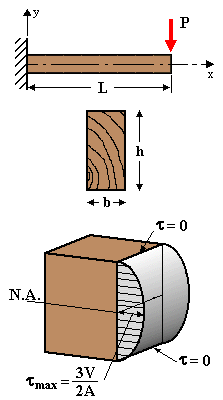|
Example 6.4.1
Given: The rectangular beam, built in at the left end, having length, L, and cross-section of width, b, height, h, is acted upon by a point load, P, at its free end.
Req'd: Determine the shear stress at the top, bottom and neutral axis at a cross-section in the beam.
Sol'n: The shear force, V(x) = P, is constant across the entire beam. At the top (or bottom) surface (y = ±h/2), y* = h/2 and A* = 0, therefore t = 0.
At the neutral axis (y1 = 0), y* = h/4 and A* = bh/2. Thus:

The shear distribution, calculated as a function of y (=y1), is a parabola, given by the function:


Note that these equations for t(y) are only valid for beams of rectangular cross-section.
|

Note: shear-stress acts parallel to the beam-face. The parabola is a plot of the magnitude of the shear stress.
|










